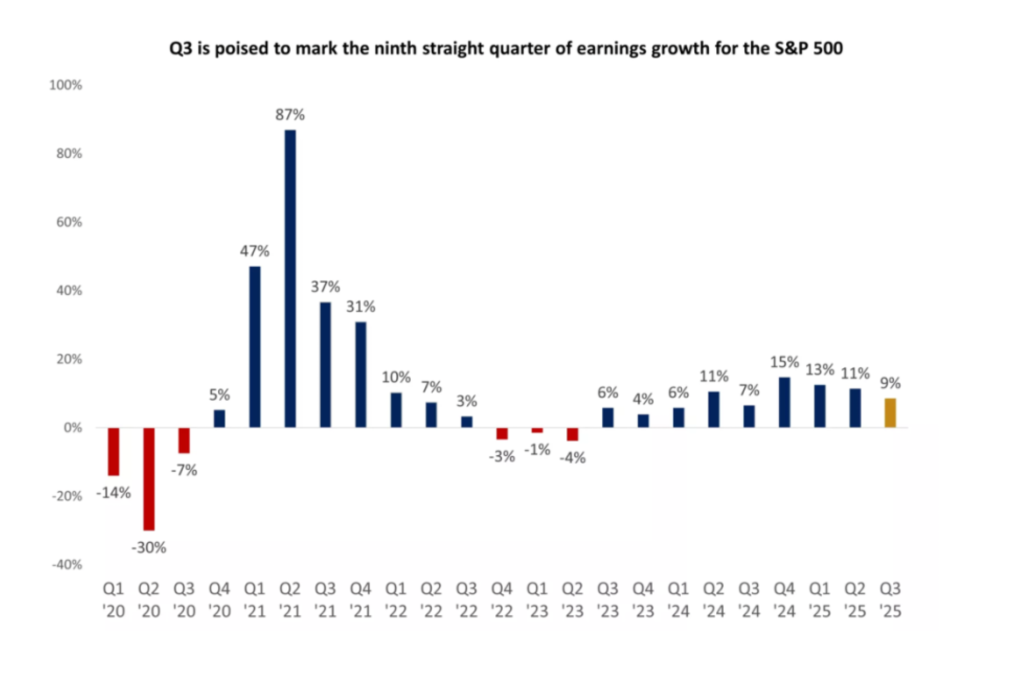Global markets weekly update
28.10.2025

U.S.
- Each of the major U.S. indexes posted a gain of around 2% as stocks rebounded from a setback the previous week. However, stocks’ weekly gains didn’t come easily, as worries over trade policy and regional bank credit risks generated considerable volatility (the VIX reached its highest level since April) notably for assets such as cryptocurrencies and gold.
- Gold futures surged more than 5% for the week and achieved their ninth weekly gain in a row, reaching as high as USD 4’392 per ounce on Friday. The price of Bitcoin fell to its lowest level in three months below USD 104’000, 17% below a record high of more than USD 126,000 reached less than two weeks earlier.
- The major U.S. banks that initiated the earnings season (JPMorgan Chase, Citigroup, and Wells Fargo) exceeded analysts’ Q3 profit and revenue expectations. As of Friday, analysts projected that financials sector earnings rose 18.2%, above the 8.5% growth forecast across all sectors in the S&P 500, according to FactSet.

- This week will see a rush of corporate earnings results, with big tech leader Microsoft, Amazon, Apple, Alphabet, and Meta all set to report quarterly results. Investors will be watching to see whether Big Tech has managed to keep delivering on the lofty expectations that have accompanied the AI boom. A minority of U.S. mega-cap technology stocks are expected to continue generating a disproportionate share of overall earnings growth. Analysts expected that the Magnificent Seven generated Q3 growth of 14.9%, according to FactSet. In contrast, the other 493 companies in the S&P 500 were projected to produce growth of 6.7%.

Europe.
- The Eurostoxx 600 ended the week 1.68% higher. Major stock indexes rose as well. Germany’s DAX gained 1.72%, Italy’s FTSE MIB added 1.44%, and France’s CAC 40 Index was up 0.63%. The UK’s FTSE 100 Index climbed 3.11%.
- Headline annual inflation in the UK unexpectedly remained steady at 3.8% for a third consecutive month, slightly lower than the 3.9% expected. Core inflation, a measure of underlying price pressures, eased to 3.5% from 3.6% in August, supporting hopes for a reduction in interest rates in December.
- Meanwhile, retail sales unexpectedly expanded for a fourth consecutive month in September, rising 0.5% sequentially, largely surpassing expectations of a 4% drop.
- Eurozone business activity accelerated in October, hitting a 17-month high. Eurozone Composite PMI Output Index reading was 52.2, up from 51.2 in September and ahead of consensus estimates for around 51.1. The services PMI climbed to a 14-month high of 52.6, while the measure for manufacturing rose to 50.0 from 49.8.
Japan
- Japan’s stock markets rose sharply over the week, with the Nikkei 225 Index up 3.61% and the broader TOPIX Index climbing 3.12%. Markets welcomed the election of the Liberal Democratic Party’s (LDP) Sanae Takaichi as Japan’s prime minister, as her focus on the economy and proactive fiscal policy are likely to be positive for stock prices. Given the LDP formed a coalition with the Japan Innovation Party (JIP), Takaichi’s government can be expected to become relatively stable.
- Growing assumption that Takaichi could announce a large-scale stimulus package in the near term led to a lower yen, with the yen weakening to JPY 152.9 against the USD, from JPY 150.6 at the end of the prior week. The next interest rate increase is not expected until December at the earliest.
- On the economic data front, inflation remained above the BoJ’s 2% target, with the core CPI rising 2.9% year over year in September, matching expectations and accelerating from the prior month’s 2.7%.
China
- Chinese equities climbed over the week despite economic data highlighting weak domestic demand. The onshore blue chip CSI 300 was up 3.24% and the Shanghai Composite Index advanced 2.88%.
- China’s economy grew 4.8% in Q3 from a year ago, on track for meeting the official growth goal of 5% this year. Other data, however, highlighted the weak domestic demand that continues to hinder China’s economy. Retail sales grew 3.0% year over year in September, the slowest pace since November. A prolonged housing market slump and persistent deflation have exhausted consumer demand.
- China’s Fourth Plenum concluded on Thursday with recommendations for the 15th Five-year Plan (2026-2030). China said it aims to “greatly increase” the country’s capacity for self-reliance and strength in science and technology in the next five years. The statement also stressed the needs to building a modern industrial system and strengthen innovation in core technologies. This reflects the country’s necessity to boost productivity and achieve self-sufficiency in the face of an ageing population and Western restrictions on high-tech exports. At the same time, the document reiterated a pledge to bolster domestic consumption and expand investment, asserting to “firmly eliminate dogs hindering the building of a unified national market”.
Portfolio considerations
Equities
With valuations near cycle highs, corporate earnings growth will have to take the lead in driving further market gains and extending the bull run. Q3 results so far show resilience despite trade and labor headwinds. The foundation of the bull market also relies on the combination of a resilient economy, declining interest rates and a U.S tax bill that should kick in. Against this backdrop, we view market pullbacks, as a compelling buying opportunity and a way to rebalance, diversify into underrepresented areas with catch-up potential (cyclical sectors such as industrials and consumer discretionary, as well as the out-of-favor health care sector) and add quality names at better prices.
Fixed Income
We continue to advocate seizing the yield advantage in high quality fixed income to build resilient portfolios, especially since equity valuations remain stretched. We recommend overweighting intermediate-maturity bonds (5-7 years), also less exposed to concerns over widening government budget deficits and rising debt levels. The primary source of return will be carry and not capital gains.
